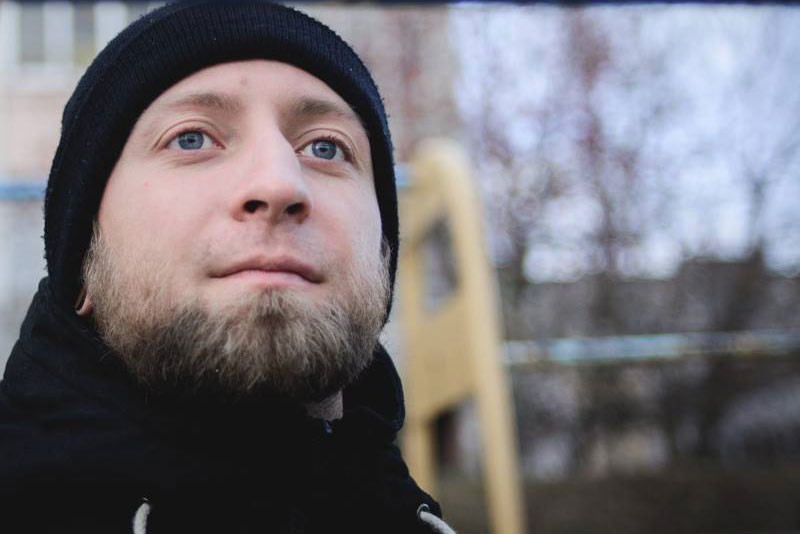Expert analysis of the prosecution of Viachaslau Kasinerau
Prepared by experts of the HRC "Viasna" Valiantsin Stefanovich and Pavel Sapelka
On March 28, it was reported that activist Viachaslau Kasinerau, who was serving a 15-day administrative detention for participation in a demonstration on February 17 in Minsk, was charged with an offense under Part 1, Art. 339 of the Criminal Code (hooliganism). The activist was taken into custody and transferred to the Interior Ministry’s pre-trial prison in Minsk.
The criminal charges stem from an action held on March 12 near the Interior Ministry’s building in Minsk, when Kasinerau threw a noose on the statue of a Russian Empire policeman, protesting against police impunity and persecution of activists of the anarchist movement.
In connection with the criminal case and pre-trial detention of Viachaslau Kasinerau, we note the following:
According to Part 1 of Art. 339 of the Criminal Code of Belarus, hooliganism, i.e. deliberate actions, which flagrantly violate public order and express an obvious disrespect to the society and are accompanied by the use of violence or threat of violence or destruction or damage to other persons’ property, or are characterized, in their content, by exclusive cynicism, shall be punishable under criminal law.
Thus, such qualifying signs of hooliganism as the use of violence or threat of violence or destruction or damage to property, as well as actions, which are characterized by cynicism, can either accompany actions grossly violating public order and expressing clear disrespect to the society or act as an independent form of gross violation of public order and the manifestation of overt disrespect for the society.
Violation of public order by itself, even if expresses in an open disrespect for the society, does not constitute a criminal offense, if the actions of the accused lack any of the above elements. [1]
A gross violation of public order can be manifested in actions that caused a failure in the conduct of a mass event, the suspension of the normal activities of an institution, enterprise, public transportation, etc., as well as damage to health, legitimate rights and interests of the person. Such actions may be expressed by long-term violations of public peace, destruction or damage of property, or beating the victims.
A clear disrespect for society is characterized by a disregard for accepted norms of behavior in society, active opposition of one’s personality to the interests of society or other individuals.
The subjective aspect of hooliganism is expressed as a deliberate act aimed at the gross violation of public order, with a motive of obvious disrespect for society.
The act committed by Kasinerau, namely throwing a noose over the statue of a police officer near Interior Ministry building, in our opinion, had no intention to violate public order, because in no way led to the disruption of the work of the Interior Ministry, other institutions, or public transport. Nor did it harm the health of others.
The action itself was short-term and could not lead to the disturbance of the peace of other citizens. Moreover, it was committed late in the evening, when there were no passers-by at the location. Thus, in our opinion, it cannot be stated that Kasinerau’s action constituted a gross violation of public order or expressed clear disrespect for society.
By committing the act, Kasinerau did not cause any damage to the statue itself, either breaking or destroying it.
Nor can it be argued that Kasinerau’s actions were associated with particular cynicism, since particular cynicism as an element of hooliganism is understood in the actions that breach public order and express disrespect for society, as contempt for the basic moral values of society. Exceptional cynicism, in particular, may be manifested by obscenity, mockery of the sick, the elderly, persons who are in a helpless state, abuse of customs and traditions, etc.
The statue is not of historic or architectural value (not entered in the register). Likewise, one cannot argue that the statue is a reflection (symbol) of some national traditions or customs of the peoples of the Republic of Belarus, symbolizing the memory of the sacrifices made by our country in many wars and revolutions. Nor is it a monument to Interior Ministry employees who died in the performance of their duties. In fact, the sculpture is one among hundreds of statues installed in the streets of cities across Belarus.
In summary, we believe that the actions of Viachaslau Kasinerau do not constitute an offense under Part 1, Art. 339 of the Criminal Code.
Information about the action was published by some online resources. An analysis of the texts describing the video footage of this action allows us to conclude that by committing the act Kasinerau publicly voiced his opinion about the illegal actions of the police officers which, in his opinion, have taken place in the past few months (a recent case of the use of firearms by a police officer against a resident of Minsk, detentions of citizens in public transport after the legal demonstration on March 15 and others).
It should be noted that every person has the right to freedom of expression; this right shall include freedom to seek, receive and impart information and ideas of all kinds, regardless of frontiers, either orally, in writing or in print, in the form of art, or through any other media of his choice.
The right to freedom of expression implies special duties and responsibilities, and therefore may be subject to some restrictions, which can be used both towards separate individuals and the society as a whole. However, if the State imposes certain restrictions on the exercise of the right to freedom of expression, these may not put in jeopardy the right itself. The International Covenant on Civil and Political Rights sets out the conditions, under which such restrictions can be set. First, the restrictions must be “prescribed by law”, and second, they must pursue one of the purposes: to respect the rights and reputation of others, to protect public safety, public order, public health or morals; and the state must prove that they are “necessary” to achieve one of these goals.
The case of the prosecution of Viachaslau Kasinerau, who expressed his opinion regarding the activities of law enforcement agencies, which are public in nature and, accordingly, may be subject to criticism from citizens, does not suggest that by thereby limiting the activist’s freedom of expression the government pursued one of the above objectives.
It seems that such a disproportionately harsh reaction to the act was caused solely by the fact that the statue was unveiled by representatives of the Interior Ministry during the festive events on the occasion of the 100th anniversary since the establishment of the Belarusian police (as a result of the February Revolution in Russia in 1917, an all-Russian militia to protect public order was set up in Minsk).
It is also worth noting that this is not the first attempt to isolate and prosecute Viachaslau Kasinerau by law enforcement agencies. In particular, on 11 August 2015, riot policemen detained youth activists Maksim Piakarski, Vadzim Zharomski, Viachaslau Kasinerau and Yaraslau Ulyanenkau on suspicion of involvement in painting political graffiti on the walls of several buildings in Minsk. Maksim Piakarski and Vadzim Zharomski were charged under Part 2, Art. 339 of the Criminal Code (hooliganism). Both were taken into custody and placed in the Interior Ministry’s detention center. After human rights defenders’ vocal reaction to the detention, on August 31, Piakarski and Zharomski were released from custody on bail. During the arrest, Viachaslau Kasinerau was badly beaten, as a result of which he was hospitalized. Human rights organizations said that the charges were politically motivated. As a result, during a hearing at the Frunzienski District Court of Minsk on January 9, Kasinerau faced milder charges under Art. 341 of the Criminal Code (destruction of property). The activist was eventually sentenced to a fine of 630,000 BYR. It is worth recalling that the persecution of Kasinerau was accompanied by extensive propaganda on national television, in which he was accused of extremist and even inciting ethnic hatred, although he never faced such charges.
These circumstances allow us to conclude that the authorities used political motives in order to prosecute Viachaslau Kasinerau and thus sanction his public activity.
[1] Resolution of the Plenum of the Supreme Court of the Republic of Belarus of 24 March 2005 No. 1 “On judicial practice in criminal cases on hooliganism”


















